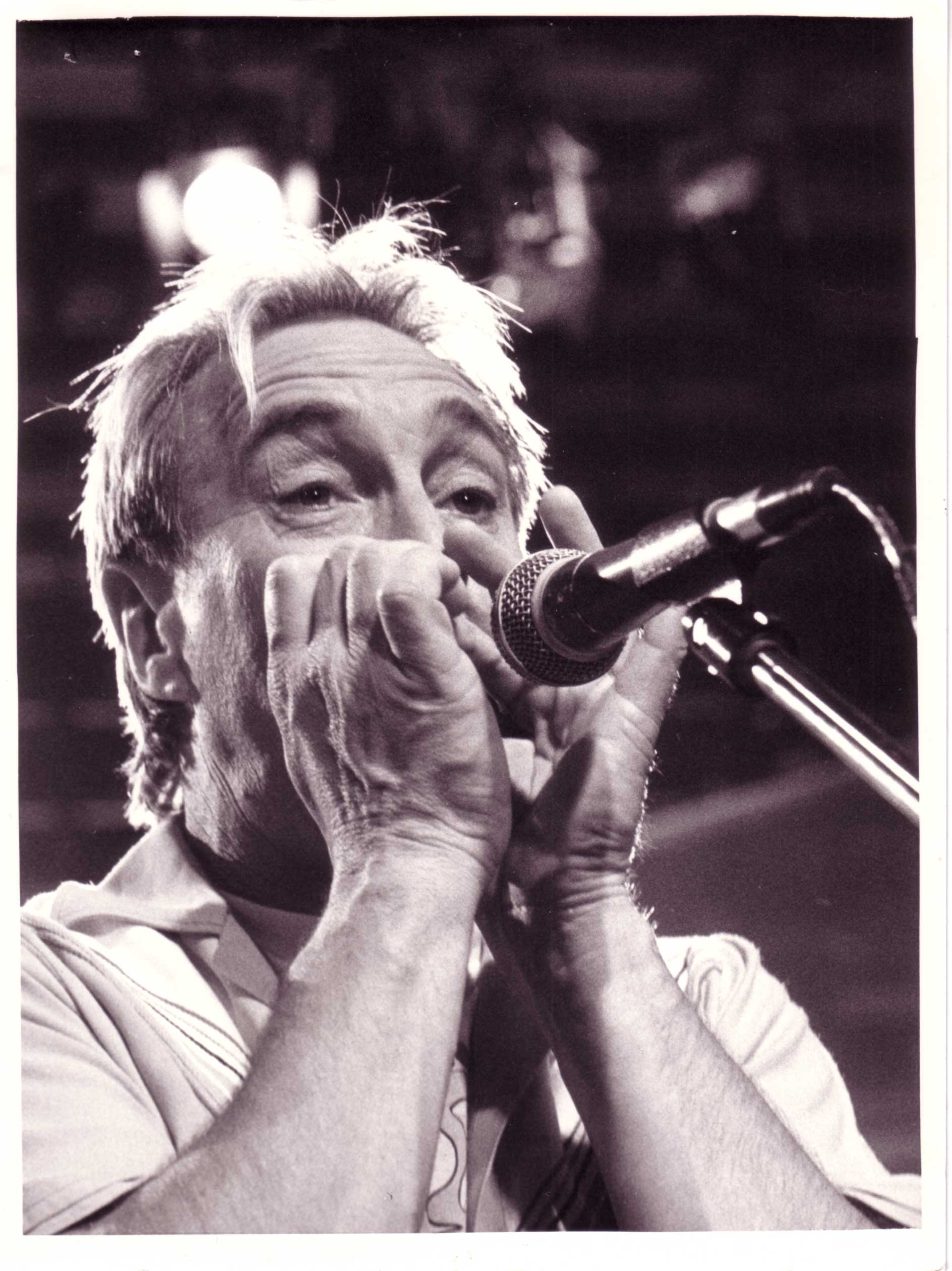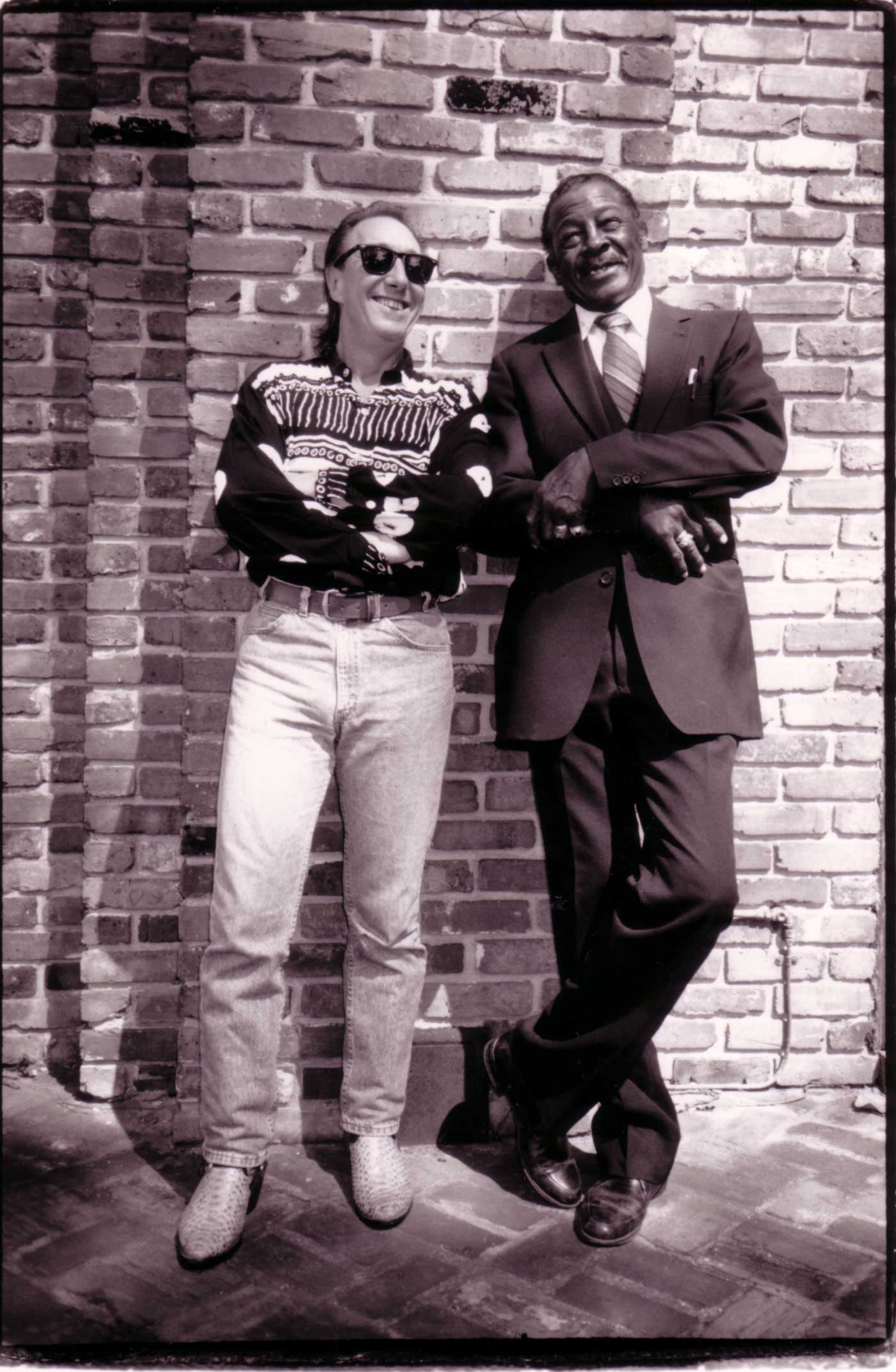



Blues man Midge Marsden has bled for his music. When the Taranaki-born musician first learnt to play the harmonica, he practiced until his lips were rubbed ragged. "You spend hours and hours at it and your mouth would be raw, your lips would be raw with skin that's come off" he says.
His harmonica-howling days began back in the 1960s, while playing second guitar for The Breakaways. At the time, British bands Manfred Mann, The Rolling Stones and The Animals began adding the moan of the mouth organ to their yowling guitars and Midge was inspired. "I thought, 'Wow, I can do that'."
So, he taught himself to play by listening to the best. Because he knew of no harmonica teachers in New Zealand, Midge turned to the records of jazzy bluesmen Sonny Terry, Brownie McGhee and Sonny Bill Williamson. He listened and played until he finally got the feel of it. "I think it's the only instrument you can't see what you're playing" he says. "If it's a horn instrument, if it's a violin, a viola, you've got your fingers to watch. With a harmonica, it's in your mouth, you can't see where you're going next. It's all feel…"
Slowly, surely, lips bleeding after long practice sessions, Midge mastered the art. "When I hear the harmonica playing on those Breakaways records… it was a bit ropey" he says.
"Of course, since then I've sort of learnt how to get it down a bit more. I just play now - I don't think where I'm going, it just happens naturally." While Midge got better at playing, his lips got worse. "Yes, I have this great big thing, especially in this corner here, which I fondly call 'harpies'," he says touching his mouth. "Blues harp you see - harpies. "If I'm on tour for like two or three weeks, a month, or six weeks like we used to, you end up with this great big permanent sort of scab on here. Because every night you start again, and it starts to heal and you un-heal it."
When interviewed in 2004, the 59-year-old didn’t have such a hectic schedule, apart from his annual Christmas pub tour. "But these days the harmonica is a little more user friendly. The reeds are plastic as opposed to wood."
Midge goes through harmonicas faster than most men go through underpants. Over the years he's had “hundreds, hundreds, hundreds”. He takes up to 60 with him on the road. "You try to have two or three harmonicas of every key. Because if one craps out, which they do, you've got to throw it into the fixit box - they don't very often get fixed - and you grab another one."
If his harmonica drops a reed on stage, his backing musicians (if he has any) are in danger. "I just go over my shoulder" he says, like a man tossing salt for good luck. "I throw them, and grab the next one and carry on. "They're a very high risk instrument to be involved in" he says, explaining that it's not the done thing to return a broken one filled with spittle.
Midge buys his Hohner harmonicas in bulk at trade price from a factory in Petone. "About a thousand dollars’ worth at a pop" he says.
The history of the harmonica goes back to Europe in 1821, when 16-year-old Christian Friedrich Buschmann registered the first European patents for his new musical invention called an aura. This was a basic harmonica, which was widely imitated and bettered.
About 1826, a Bohemian instrument maker named Richter developed a variation that Europeans referred to as the Mundharmonika or mouth organ.
Nearly 30 years later, German clock maker Matthias Hohner began manufacturing harmonicas full-time with the help of his family and a hired workman. He was able to produce 650 instruments that year. Soon after, he added local workers and developed mass production techniques. By 1887, Hohner was producing more than one million harmonicas each year. Today, the company produces more than 90 different models of harmonica. "They (Hohner) have been making them forever, but I don't think they ever considered they'd be played the way the black people started using them" Midge says. "They were all designed to play 'funiculee funicular', that sort of stuff. And there's all kinds of harmonicas, big ones, long ones, big bass ones." There's even a harmonica orchestra, with each member playing a different type of the same instrument.
Midge's style is the blues-based, there's-a-train-a-comin' kind, which originates from the deep south of the United States.
"I played in New Orleans a couple of times… and these guys said, 'Wow, where did you all learn to play like that?'" Midge imitates the southern drawl.
"I said, 'New Zealand'.
"'Really?'
"So obviously I'd reached the stage where they considered I was good enough to be playing with anyone. When I played in Mississippi with Willie Foster he thought I played good too" he says of the famous blues musician. "I knew that at that stage I'd reached a point where I could play blues harmonica reasonably competently, without just huffing and puffing and blowing anything that came into my head. I had some sort of structure to it; I understood how it all worked."
The first time Midge played in Mississippi - back in the mid-1980s - it was like a dream come true.
"The cheek of it - a white boy from New Plymouth getting up in a black-only juke joint" he says, explaining that juke is African for dance.
Midge and his band got taken to the joint, called The Flowing Fountain, by a black friend, but still the Kiwi musicians found the situation daunting. "There were people with guns and stuff. She was wild in there."
Standing on the stage with guitar in hand, harmonica set up in front of him, Midge spoke to his band. "I said 'This is it; this is what I have lived for all my life. This is the proof of the pudding; this is the ultimate'." He explains why: "White people playing their [black] music in their backyard and being accepted for it."
Before the Midge Marsden Band began to play, the audience just stared. "They look at you" Midge says cocking his head back, squinting his eyes. "They were curious, 'who are these people'?"
Once the New Zealanders burst into the blues, people sitting around the tables began to exchange looks and nod in slow approval. Midge reckons they were thinking, “Not bad for a white boy”. In fact, the locals were mighty impressed with the band from Down Under. But, about 3am, the band's chaperones decided it was time for the visitors to split the joint. "We were told, 'It's too dangerous for you folks to be around'. They said, 'We lost three last week'."
Midge asked: "What do you mean you lost three?"
The reply: "Three people were shot (outside)."
As an aside, Midge says he had to hit the ground when a gunfight broke out once in Texas. "When they go off it's disappointing - it's not like the movies. They don't go 'bang, bang, bang'. They go 'pop, pop, pop'."
Back on the blues trail, deep in the Delta, Midge is still in The Flowing Fountain and the band is being asked to leave. "We wanted to stay. We were having so much fun." But their hosts, noticing some customers getting drunk and belligerent, were insistent. "They don't fight with fists," Midge explains. "Out come the guns. She's the wild, wild south, boy I tell you." Especially in that jumping joint. "It was on Nelson Street, a bad arse part of town in Greenville," he drawls.
While some of the clientele may have been dodgy dudes, the audience was mixed, with people from ghettoes and the top echelon of society tapping toes side by side. "The No 1 Supreme Court judge was a black man and he was there." There was also a top black lawyer, sitting around with people at “the bottom of the social pile”. "That's the way they share their lives. Juke joints have always been a social point for these people's lives" Midge says. "By and large they were really friendly people, but you don't understand a word they are saying. You haven't a clue what they are saying, so you just nod and smile." Or talk in the language they understand the best - the blues. And the heart-humming howl of Midge on his harmonica.
Search the Puke Ariki Heritage Collection
LinkPlease do not reproduce these images without permission from Puke Ariki.
Contact us for more information or you can order images online here.